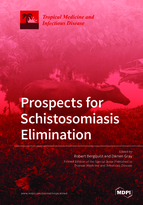Prospects for Schistosomiasis Elimination
A special issue of Tropical Medicine and Infectious Disease (ISSN 2414-6366). This special issue belongs to the section "Vector-Borne Diseases".
Deadline for manuscript submissions: closed (30 November 2018) | Viewed by 128570
Special Issue Editors
Interests: epidemiology; medical parasitology; neglected tropical diseases (NTDs) with special reference to schistosomiasis, diagnostics, chemotherapy, vaccinology, remote sensing, and other geospatial techniques
Special Issues, Collections and Topics in MDPI journals
Interests: global health; tropical health; international health; infectious disease epidemiology; Schistosomiasis; soil-transmitted helminths; clinical trials; medical parasitology
Special Issues, Collections and Topics in MDPI journals
Special Issue Information
Dear Colleagues,
This Special Issue focuses on current efforts to limit the ravages of schistosomiasis with a view to eliminate this helminth, parasitic infection as a public health issue on a world-wide scale. Excellent progress has moved China and several countries in North Africa and the Middle East close to the elimination of schistosomiasis and this provides hope that the reign of the 'God of Plague' is near. The disease has, however, still a strong presence in sub-Saharan Africa with endemic areas stretching from Latin America to Southeast Asia putting more than 800 million people at risk, while the number of those actually infected remains as high as somewhere between 200 and 250 million people, the majority living in low- and middle income countries. Schistosomiasis is one of the neglected tropical diseases (NTDs) targeted by the World Health Organization for increased control and eventual elimination in the next 10–20 years. Morbidity control has in principle been achieved thanks to large-scale, repeated chemotherapy with praziquantel, but there are still areas with many cases of advanced disease. The next steps involve interruption of transmission through effective control of the intermediate snail host and preventive measures and, for areas endemic for Schistosoma japonicum and S. mekongi, also control of the infection in domestic animals. However, due to the chronic nature of schistosomiasis lasting sequelae (post-transmission schistosomiasis) needing lifelong management, the impact of schistosomiasis may well continue to be felt for a long time after transmission has been curbed. Control methods used include chemotherapy, snail control through mollusciciding and environmental management, health education and water, sanitation and hygiene (WASH) interventions. The current arsenal includes an excellent drug and highly sensitive and specific diagnostic techniques but there is still need for new complementary drugs and vaccine development.
Prof. Robert Bergquist
Assoc. Prof. Darren Gray
Guest Editors
Manuscript Submission Information
Manuscripts should be submitted online at www.mdpi.com by registering and logging in to this website. Once you are registered, click here to go to the submission form. Manuscripts can be submitted until the deadline. All submissions that pass pre-check are peer-reviewed. Accepted papers will be published continuously in the journal (as soon as accepted) and will be listed together on the special issue website. Research articles, review articles as well as short communications are invited. For planned papers, a title and short abstract (about 100 words) can be sent to the Editorial Office for announcement on this website.
Submitted manuscripts should not have been published previously, nor be under consideration for publication elsewhere (except conference proceedings papers). All manuscripts are thoroughly refereed through a single-blind peer-review process. A guide for authors and other relevant information for submission of manuscripts is available on the Instructions for Authors page. Tropical Medicine and Infectious Disease is an international peer-reviewed open access monthly journal published by MDPI.
Please visit the Instructions for Authors page before submitting a manuscript. The Article Processing Charge (APC) for publication in this open access journal is 2700 CHF (Swiss Francs). Submitted papers should be well formatted and use good English. Authors may use MDPI's English editing service prior to publication or during author revisions.
Keywords
- Schistosomiasis
- Neglected tropical diseases
- North Africa
- Sub-Saharan Africa
- South East Asia
- Latin America
- Middle East
- Elimination
- Eradication
- Control
- Integrated intervention
- Mathematical modelling
- Diagnostics
- Praziquantel
- Chemotherapy
- Snail control
- Transmission
- Vaccine development
- Zoonoses
- One Health







